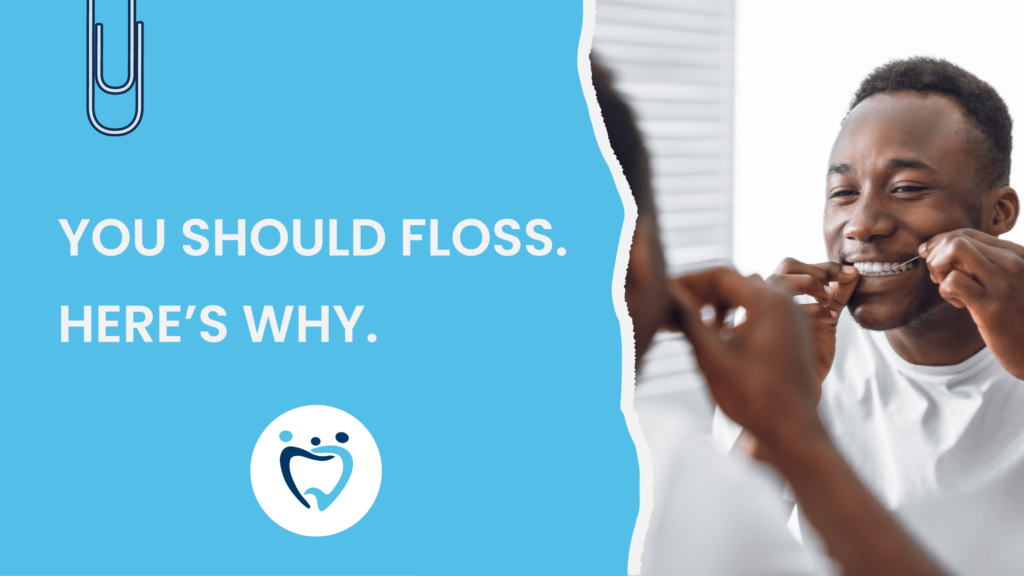15 Nov Here’s Why You Should Floss

Each dentist visit, we all dread being asked “Do you floss?” The question can’t be avoided, and since the majority of Americans don’t floss consistently, our gums bleed during the cleaning, effectively answering the question.
Why bother with flossing? It seems to be everyone’s least favorite part of dental hygiene. After all, is there any real benefit? Flossing doesn’t deliver the minty satisfaction you get from brushing your teeth. It isn’t as quick and simple as using mouthwash, and it doesn’t produce visible effects like teeth whitening. Flossing, however, is the most inexpensive habit of them all, only requires a few minutes a day and provides serious benefits.
Flossing removes much more than just that annoying piece of spinach stuck in your teeth. The food that’s ruining your perfect smile might be a minor irritation, but the real dangers are nearly invisible: plaque and biofilm.
“The food is just a piece of food,” periodontist Dr. David Basali writes, “It’s the bacteria building up around the teeth that will cause the inflammation, the cavities, and the dental disease.” Bacteria that live in your mouth metabolize nutrients in your saliva. On your teeth, your saliva causes hundreds of different types of bacteria to stick together, causing a biofilm to form and cling to your teeth. Most of us know this biofilm better by another name: plaque. When plaque builds up on your teeth it can lead to periodontal diseases, which threaten your gums and lead to permanent tooth decay.
Flossing is one of the easiest and least expensive ways to protect your teeth, and just flossing for a few minutes daily protects you against two serious diseases: gingivitis and periodontitis.
Flossing prevents gingivitis and periodontitis.
Worldwide, billions of people suffer from gingivitis. In minor cases, gingivitis causes bleeding while flossing, but can also inflict severe pain, and create difficulties in eating and speaking.
Periodontitis is a disease produced by bacterial biofilm, which causes your teeth and the surrounding tooth structure to decay. These gum diseases, if unchecked, lead to eventual tooth loss and the need for surgery. So how can you avoid them? According to the National Library of Medicine, these serious conditions can be prevented by the simple daily action of flossing. “As dental plaque is the primary cause, self-administered daily mechanical disruption and removal of plaque is important for oral health. Toothbrushing can remove supragingival plaque on the facial and lingual/palatal surfaces, but special devices such as floss are often recommended to reach into the interdental area.”
The interdental area is any place where the sides of our teeth touch each other. This makes it easy for harmful bacteria to build up, and these cracks are impossible to clean with just your toothbrush. If you brush your teeth every day but you forget to floss, two sides of each tooth will never get cleaned! This makes you much more likely to end up with a cavity and develop diseases like gingivitis and periodontitis.
How should you be flossing?
Are there right and wrong ways to floss? According to a study conducted by TUFTS University, the answer is yes! Some methods of flossing are proven to be much more effective than others. In the study, researchers focused on bleeding gums, which are a common marker of potential gingivitis. Almost half of all adults in the US have moderate gingivitis, easily identified by one key symptom: gums that bleed when touched or flossed. The control group was instructed to
floss as they normally would, while the other participants in the study were trained in proper flossing technique. The technique they were taught is known as the “adapted horizontal vertical flossing technique,” or AHVFT. Eight weeks later, the control group who had stuck to their normal flossing routines saw a 30% improvement in gum health, but the group that had been taught to floss properly experienced a 70% improvement. The researchers found that “positive gingival health outcomes with dental flossing may be technique sensitive.”
So while this study shows that casual flossing with bad technique can still have a slight impact, proper technique is key if you want to achieve the best results.
If done carelessly, flossing can seriously damage your teeth and gums by causing inflammation, and using too much force when flossing your teeth can accidentally ruin dental work. If you have braces or dental implants, be cautious when flossing. Although it’s rare, if you don’t floss often and your gums bleed during occasional flossing, then flossing or even daily brushing can dislodge harmful bacteria into your bloodstream, which can lead to infection. Although this sounds dangerous, you can prevent this from happening to you by daily gentle flossing, as long as you’re using the proper technique.
So, what is proper flossing technique?
The American Dental Association recommends the following steps for best flossing:
1. Wrap each end of a 15- to 18-inch length of floss around the ring or middle finger of both
hands; the floss remaining between the fingers should be about 5 to 6 inches long.
2. Hold the useable floss with the index finger and/or thumb of each hand. Use only 3/4″ of
floss between the fingers of each hand. These fingers will control the floss and should
keep it from cutting into the gums.
3. Start at one end of either the top or bottom set of teeth and apply the floss to the curved
surface of the tooth, like bending a “C” around the tooth.
4. Move the floss in a short forward-backward motion, as well as upwards and downwards,
as if drying your back with a towel.
5. Continue to the next tooth, using the floss to clean both edges of the teeth.
6. Break off about 18 inches of floss, wrapping most of it around one of your middle
fingers. Wind the remaining floss around the same finger of the opposite hand. This
finger will take up the floss as you move along.
7. Hold the floss tightly between your thumbs and forefingers.
8. Guide the floss between your teeth using a gentle, rubbing motion. Never snap the floss
into the gums.
9. When the floss reaches the gum line, curve it into a C shape against one tooth. Gently
slide it into the space between the gum and the tooth.
10. Hold the floss tightly against the tooth, slightly away from the gums. Gently rub the side of the tooth
with an up-and-down motion, following the shape of the tooth. Repeat this method on the rest of your teeth, top and bottom.
Don’t forget the back side of your last teeth (at the very back of your mouth.)
Using this technique will keep your teeth and gums healthy and will reduce the risk of
unintentional damage.
Ideally, you should floss two times a day, but if you’re still struggling to make flossing a habit,
even flossing just once daily provides serious benefits.
See the video at the bottom of this post for more information!
Should you floss before or after you brush your teeth?
There’s a general consensus among dentists that you should floss before you brush your teeth.
This ensures that all the bacteria and food particles that are loosened during flossing are brushed
away. A study published in the journal Oral Health and Preventive Dentistry backs this up. The
researchers discovered that when you floss your teeth before brushing, both the plaque control
record and plaque index (PI) are significantly lower. It’s better to floss first and brush
second.
According to Dr. David Basali, there’s a second advantage to flossing before you brush. Using a
floss-first method makes it easier to stay consistent! Dr. Paul Levi recommends also flossing first
as a way of enforcing the habit of flossing. The reward of the minty fresh feeling you feel after
brushing your teeth makes it too easy to forget flossing afterward and walk away after only
brushing your teeth. Flossing first, however, makes it more likely that you’ll stick with the habit.
What kind of floss should you be using?
Traditional floss hasn’t changed much since its invention in the early 1800s.
American dentist Levi Spear Parmly was the first dentist to recommend flossing, and by 1874 the first floss had been patented. It took another thirty years before the American Dental Association finally began to recommend the practice, but flossing has been a household routine ever since.
In the last few years, however, new ways to floss have arrived on the scene. One of these new methods is interdental brushes, sometimes called IDBs. IDBs are tiny brushes used to clean in between your teeth; you might be familiar with them if you’ve ever had braces.
Studies suggest that using an IDB may work just as well as traditional floss, if not better. IDBs can be less messy to use when you floss your teeth, and many people find them easier than attempting to use traditional string floss.
Another alternative to traditional floss is the Waterpik, which uses pressurized water to clean the cracks between your teeth. A study published in the Journal of Clinical Dentistry compared the efficacy of a water flosser to traditional string floss, and the researchers found that the group who used the Waterpik had a 74.4 percent reduction in plaque compared to a 57.7 percent reduction in the group who used the string floss.
Waterpiks are moderately expensive, and can be messy to use, but are significantly more effective than basic string floss. For those who have braces or dental orthodontics, water flossers can make flossing easier and less time-consuming.
If you struggle with forgetting to floss, a water flosser might help you! Waterpik users report experiencing a satisfying clean feeling after using a water flosser to floss their teeth, which makes them enjoy flossing instead of dreading it. Do your gums bleed when you floss? Water
flossers are gentler on the gums, so if your teeth and gums are sensitive, consider investing in your health by buying a Waterpik.
It’s important to remember that neither a water flosser nor an interdental brush is a substitute for brushing your teeth. Tooth-brushing is still a vital step in caring for your dental health, regardless of what floss you choose to use.
Floss picks are a popular option, but they can’t wrap around the tooth like traditional floss can, which makes them significantly less effective. If your options are limited, however, floss picks can be a great option to keep in your purse or backpack. Regardless of which method you choose, the important thing is to floss consistently and to use the proper technique.
Does learning to floss properly sound too difficult? Remembering to floss daily is only a small habit, but it delivers big results. Taking your chances with dental disease just isn’t worth it. After all, Mom was right. “You don’t have to floss all your teeth, just the ones you want to keep.”

About Our Team
Our team of dental experts has well over 30 years of combined experience in the field of dentistry. To learn more about our Augusta Family Dental family, please visit the team pages for Hephzibah, Washington Road, Summerville, and Medical District locations.

Sorry, the comment form is closed at this time.